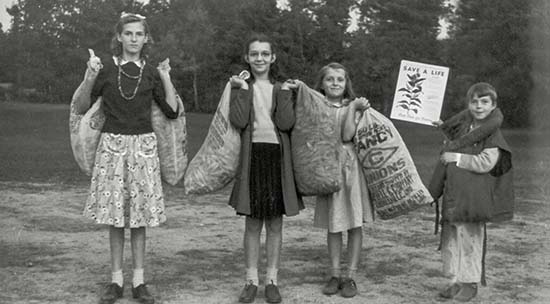 |
 |
| current issue |  | past issues |  | send a letter/news |  | address update |  | advertise |  | about us |  | alumni home |
On Ben's Farm
|
Pod Squad Children harvest milkweed to aid the war effort. By Mylinda Woodward '97 |
|
 University Archives |
When the order came, on Sept. 15, 1944, thousands of schoolchildren in New Hampshire and Vermont marched into the fields, bags in hand, to do their patriotic duty: It was "Go Day" for the milkweed pod collection program. The students were harvesting for a cause. Their mission? Providing life jackets for U.S. troops fighting in World War II.
The need was urgent. Before the war, seed pods from the kapok tree in Indonesia had provided filling for life jackets. But once the Japanese captured the East Indies, the kapok supply was cut off—and now the U.S. military needed 1.5 million pounds of filling to keep U.S. soldiers safely afloat. Milkweed, it turned out, was a good substitute. Covered by a thin coating of wax, milkweed floss is six times more buoyant than cork. But the trick was to collect it at precisely the right time: as soon as the pods were ripe, but before they split and scattered their contents on the wind.
The war office turned to the public for help. UNH horticulture professor William Smith, who had been given leave from his university duties to oversee the program for New Hampshire and Vermont, asked farmers, gardeners, and road workers not to mow milkweed-heavy areas. Members of the Boy Scouts, 4-H, and Junior Red Cross pitched in, too, helping to record where they saw the plant growing in anticipation of the harvest. Smith, meanwhile, monitored sites throughout both states, keeping an eye on the pods so he could give the word and activate the pod-collecting troops—most of whom were children, since labor was in short supply due to the war effort.
When Go Day came, the locals went to work, spurred by the rallying cry that appeared on wartime flyers: "Save A Life. Pick Pods for Victory." Harvesters filled mesh bushel bags with pods, collecting 20 cents for each completed bag. The bags were then delivered to a collection site—often the local school—and hung to dry before being trucked to Michigan, where the floss was removed, separated from the seeds, and stuffed into life jackets.
On November 1, Smith declared the 1944 milkweed collection campaign complete. Vermont had contributed 1,246 bags of pods, and New Hampshire, 12,020. Nationally, more than 1.5 billion pods were collected to produce more than 1.2 million life vests. Mission Milkweed Pod was complete. ~
blog comments powered by Disqus

